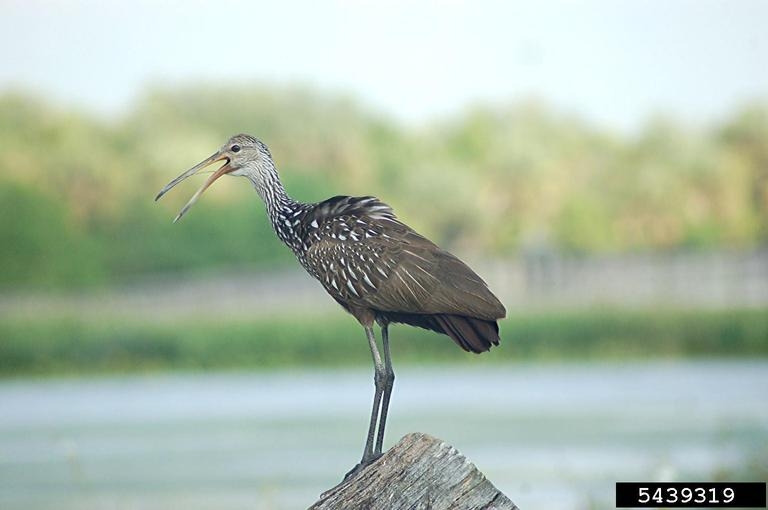As it walks in its marshy habitat, its ungainly stride makes it look as if the bird is limping, hence the common name of Limpkin. Aramus, the genus name, comes from the Greek meaning sword and the species name guarauna from a Tupi (Brazilian) language and meaning marsh bird. And indeed the Limpkin is a marsh bird with a beak like a sword. The only species in its family, Aramidae, the Limpkin is found in southern Georgia and Florida, Mexico, Central and South America, and the Caribbean.
Limpkins are closely related to the Rallidae (rails, coots, and moorhens) and Gruidae (cranes) families, the two otherrfamilies making up the order Gruiiformes – Limpkins do look a bit like small cranes. Inhabiting lakes, swamps, and marshes, the Limpkin stands over two feet tall with its long legs, resembling an immature heron. It is brown with white spots and streaks.
The Limpkin is a nocturnal hunter with a large part of its diet being made up of apple snails, but it also eats frogs, tadpoles, and insects. Its long, pointed bill is slightly curved and is yellow with a black tip. The bird’s bill is well adapted to capture and eat apple snails. When the Limpkin’s bill is closed, there is a gap just behind the tip that helps the bird use its bill like tweezers to remove snails from their shells. In some limpkins the tip of the bill is also curved to the right just a bit to make it even easier for the limpkin to slide its bill into the shell of the apple snail. Foraging is done by walking in shallow water, visually identifying food items as it walks. Limpkins will also probe in mud and below water. Upon locating a snail, they will typically move to dry land before extracting the snail from its shell.

In the early 20th century Limpkins were hunted for food, almost to the point of extinction. They recovered thanks to conservation efforts and legal protection, but habitat loss remains a threat. And, as the freshwater wetlands the limpkin relies upon are highly vulnerable to sea level rise and saltwater encroachment, climate change is also of great concern.
Recently Limpkins have been found in Louisiana and populations of the bird have drastically increased in Florida. Most likely, the increase in numbers of Limpkins is due to the invasion of the island apple snail, one of four non-native apple snails in the state. The native snail is 2-3 inches in length but the island species can reach five inches! Lots of food for snail eaters like the Snail Kite, Rostrhamus sociabilis. Snail kites are locally endangered in Florida but higher numbers have been seen recently. They prefer the same type of environment and diet as limpkins and are also eating the invasive island apple snails.

The limpkin is also known as the crying bird because of its call. In fact, the screeching cry of the hippogriff in the movie Harry Potter and the Prisoner of Azkaban is actually the cry of the Limpkin.